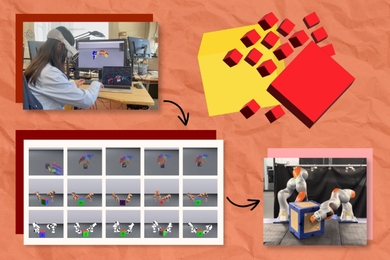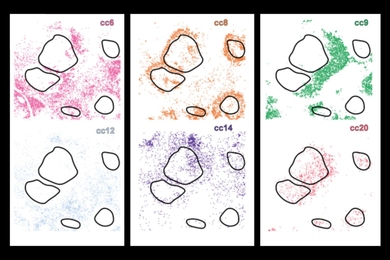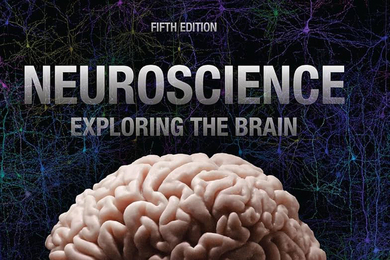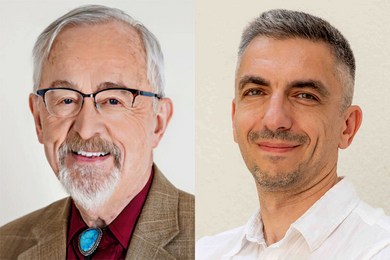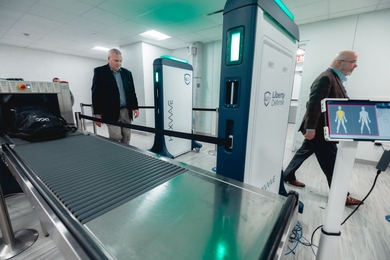On the 40th anniversary of the moon landing, current and former members of the MIT community remember what it was like, and how it shaped their lives.
MIT shaped the Apollo missions, and the Apollo missions shaped MIT. Forty years ago, computer scientists at the MIT Instrumentation Lab watched in awe as the software they designed helped land three American astronauts safely on the moon - an achievement that would inspire future generations to pursue their studies at MIT. MIT News Office writer David Chandler contacted current and former members of the MIT community to get a taste for what it was like on July 20, 1969 - and how that day changed their lives forever.
Margaret Hamilton
Was responsible for the Apollo On-Board Flight Software as director of the Software Engineering Division of MIT's Instrumentation Laboratory.
I had lived through several missions before Apollo 11 and each was exciting in its own right, but this mission was special; we had never landed on the moon before. The media, most notably Walter Cronkite, was reporting everything in great detail. Once it was time for liftoff, I focused on the software and how it was performing throughout each and every part of the mission. Everything was going according to plan until something totally unexpected happened, just as the astronauts were in the process of landing on the moon. Some things one never forgets, even after 40 years. I was standing in the SCAMA [Switching, Conference, And Monitoring Arrangement] room at Draper [the Instrumentation Lab, which later became Draper Laboratory] listening to the conversations between the astronauts and Mission Control when all of a sudden the normal mission sequences were interrupted by priority displays of 1201 and 1202 alarms, giving the astronauts a go/no go decision (to land or not to land). I looked across the room at Fred Martin and he back at me. What could possibly cause these alarms to be triggered at this most crucial time? It quickly became clear that the software was not only informing everyone that there was a hardware-related problem, but that the software was compensating for it. With only minutes to spare, the decision was made to go for the landing. The rest is history.
I thought of all the years of preparing for this day and how fortunate I was to work with and share this experience with the many talented and dedicated people who made this possible. There was no second chance. We knew that. We took our work seriously, many of us beginning this journey while still in our 20s. Coming up with solutions and new ideas was an adventure. Dedication and commitment were a given. Mutual respect was across the board. Because software was a mystery, a black box, upper management gave us total freedom and trust. We had to find a way and we did. Looking back, we were the luckiest people in the world; there was no choice but to be pioneers; no time to be beginners.
From my own perspective, the software experience itself (designing it, developing it, evolving it, watching it perform and learning from it for future systems) was at least as exciting as the events surrounding the mission. I thought about the significance of this even as the events surrounding the Apollo 11 landing unfolded. Onboard software had discovered that the CPU was fast approaching overload and there would not be enough time to perform landing functions unless emergency steps were taken. With the software's global error detection and recovery mechanisms, nominal displays were interrupted with priority displays of 1201 and 1202 alarms. Every time the CPU approached overload, the software cleared out its entire queue of processes, restarted its functions; allowing only the highest priority ones to perform until the landing was completed. The source of the error was later found to be in the astronaut checklist document; instructing the astronaut to place the rendezvous radar hardware switch in the wrong position, thus stealing valuable CPU time. The mechanisms the software used for this emergency were thought by many to have saved the Apollo 11 mission.
Jeffrey Hoffman
Professor of the Practice in MIT's Department of Aeronautics and Astronautics, and former space shuttle astronaut who flew five space missions.
I was a graduate student in astrophysics at Harvard in 1969. A group of friends got together the evening of 20 July to watch the moon landing at an elegant house on Brattle Street, where one of the group was house-sitting for a Harvard professor. The house had a great media den, so after a nice dinner we all sprawled out and watched the show.
I remember that most of my friends were absolutely amazed at what was happening, because they had never thought about humans going to the moon. My reaction was very different. I grew up reading science fiction and had followed the space program closely, so I always believed we would land on the moon. My feeling was more excitement at seeing it actually happen, but not the amazement that so many of my friends felt.
At the time, I never considered the idea of becoming an astronaut as a serious career possibility, but somehow I felt close to the events that were unfolding. It marked a high point in U.S. technological achievement, and I felt it was tragic when we threw the whole Apollo system away. We are now trying to recreate the capabilities we had back in the 1960s, and I hope we will be successful. And this time we should keep on going. But regardless of what happens, that evening in July 1969 was unforgettable.
George Cherry
Was the project manager of the Apollo Primary Navigation, Guidance, and Control System (PNGCS) at the MIT Instrumentation Laboratory (which later became Draper Laboratory), from several years before the Apollo 11 landing until several months after.
In retrospect, this was the most significant and interesting time of my life. Because of my role and leadership position on the project I "manned" the MIT Mission Control Center desk [in Houston] during the epic landing. It was both a tense time and an exciting time.
I think the only heart on the project beating harder than mine was "Buzz" Aldrin's (which I could read from my Mission Control desk).
This was it for my 10 years of work on the project, which included the invention of the lunar landing guidance equations, the lunar landing guidance scheme, and the world's first digital autopilot. The excitement mounted as the moment to land approached - and went through the mission control center roof when the PNGCS computer sounded a 1201 and a 1202 alarm.
These alarms meant that the PNGCS computer had run out of execution time. While we never saw this phenomenon in our many simulations, we had anticipated the unlikely, and programmed the computer so that if the unlikely happened we would recover. We simply stopped computing the less critical computations and concentrated on the essential computations. When the Mission Control Officer asked me what the alarms meant and whether I thought the PNGCS was OK for landing, I opined that all the data being downlinked looked normal and it all agreed and advised the Lunar Module crew to land. And so Neil and Buzz landed, and Neil got to say shortly and historically "That's one small step for a man; one giant leap for mankind." It could have been so different.
Malcolm Johnston
Was a Systems Engineer at the MIT Instrumentation Lab at the time of the Apollo 11 landing, having worked in the lab since 1962.
Apollo 8 was really the biggest step - it was the first time leaving Earth orbit, and was probably the most impressive mission of all for us.
For the Apollo 11 landing, at that moment a few of us were in the back of the control room in Houston, ready to bail out of there if they had a problem. It's hard to describe what happened. At the time, as much as we knew this was exciting and we had worked on it so long, we were not as overwhelmed then as we were looking back on it.
Just when they touched down, everybody was choked up - we couldn't say anything. It was just the pinnacle of everything.
During the descent, with all the alarms, all that caught our attention, but it was over so fast - it's not like we were sitting there agonizing. Neil [Armstrong] was going to take over anyway. Even after the landing, we were very hesitant to have a party until the splashdown. We always worried about single-point failures. There were instances where you couldn't avoid them.
Taking the LEM [Lunar Excursion Module] off the surface was one of those. If you had a hiccup on the ascent engine, there was nothing you could do. So we were all still holding our breath. Once they got off the surface, then we'd done it all before.
James E. Kernan
Was supervisor of the Lunar Module programming and test group at the MIT Instrumentation Lab at the time of Apollo 11.
I, along with many others, was in the SCAMA [Switching, Conference, And Monitoring Arrangement] room in IL-7 [the Instrumentation Lab building] following the progress of the mission. I can remember being alarmed when the crew first reported the program alarms that occurred during the lunar descent. I couldn't imagine what was causing the alarms - we had tested the flight software extensively. (Others, notably Don Eyles, have subsequently explained these alarms.) Of course, the landing was successful and very exciting.
I was all wound up and as the night wore on the many folks departed until I was alone in the SCAMA room. I stayed because I didn't want to undertake the one-hour drive home for fear of missing something. I stayed until the crew reentered the Lunar Module and signed off. I turned off the TV and the lights and drove home with a happy heart.
David Mindell PhD '96
Professor of Engineering Systems, director of MIT Program in Science, Technology and Policy, author of "Digital Apollo" (MIT Press, 2008), and lead author of white paper "The Future of Human Spaceflight."
On June 14, 1966, a robotic spacecraft had just landed on the moon and begun transmitting images to NASA. Project Gemini was drawing to a close, Apollo hardware was beginning to emerge from factories, and Apollo software was experiencing a crisis. And on that day I was born.
I do not remember the first lunar landing of Apollo 11, nor the drama of Apollo 13, but I do remember watching the later launches and landings on television. In that sense, I am among the first of a generation - those for whom lunar landings have always been a fait accompli, for whom the 20th century's greatest technological spectacle was an accomplishment rather than a dream. Nevertheless, as a boy I was fascinated by images of Apollo. When my father brought home a book, "Apollo: Expeditions to the moon," filled with wonderful, complicated imagery, I pored through it hundreds of times. The book shaped my lifelong fascination with machinery and my later choice to become an engineer.
Alex Kosmala
Was part of the Apollo software and analysis group at the Instrumentation Lab from 1963 through the Apollo missions.
No one in those early days had any notion of the magnitude and complexity of the programming task that Apollo would eventually demand. The word "software" had not even been coined at this time. It was only later that it became evident just how major a component the software would assume in the scheme of things.
For a long time after I joined the Apollo program I had no faith that its objectives could ever be accomplished. Although we put in prodigious efforts, each in our assigned area of effort, the scope and magnitude of what yet remained to be achieved never seemed to diminish. And the speed with which President Kennedy's "by the end of this decade" was fast approaching was truly frightening. And then the end of the program seemed to have arrived with the disastrous 1967 Command Module fire.
In our rush to achieve deadlines many factors had received less than the necessary care and attention. In some ways that fire was a mixed blessing because it caused a total re-evaluation of the Apollo program. I remember heaving a sigh of relief that the flight software that we had cobbled together just prior to the fire was not now required to support the first manned mission. Even though the fire cost the Apollo schedule over a year's delay, the program was able to progress after that in an accelerated fashion and with greatly increased confidence, eventually meeting the target objective.
On the occasion of the now famous "giant leap for mankind," I was on vacation with my family on Cape Cod, glued to a black and white TV into the early hours, pacing in the living area of our vacation cabin, trying not to wake the kids. I was not in the MIT/IL mission support facility in Cambridge, where many of the Apollo troops were providing critical support in those closing moments before touchdown.
Despite all the time and effort that had been expended to that point, and the surprising success of so many preceding test missions, my original fears that this would never work and would end in disaster were still with me as Apollo 11 proceeded.
Time has since blurred recollection of my specific reactions to the events of that night: the successful landing, Neil Armstrong's historic comments, and the gallivanting on the surface of the moon. I just remember the relief and pride I felt at that moment.
Dan Lickly '54
Served as director of mission program development at the MIT Instrumentation Lab at the time of the Apollo 11 landing.
I started work on Apollo in May of 1961. I was in charge of the Reentry Guidance for the first few years through about 1964. We were very confident as we approached Apollo 11, perhaps too confident, we thought we had only to get the LEM to land on the moon and the ascent stage to return to orbit. The rest was "old hat." But still we were all watching closely as Neil Armstrong began his descent. Then we were shocked to hear of "1201 program alarm."
We knew what that was and that it should not be happening. But we had designed a system that tried hard to recover from any overload conditions. So I remember hearing [NASA computer engineer] Jack Garman shouting, "Go, go!" And on they went. Then we listened as Neil flew the LEM on and on trying to find a good spot to touchdown. Our new worry was lack of fuel remaining. But finally we heard the contact notice and then, "The Eagle has landed."
At last, we could all breathe a sigh of relief.
Jerold (Jerry) P. Gilmore SM '67
Was the Division Leader of the Inertial Subsystems Division at the MIT Instrumentation Lab (later Draper Lab) from 1962 to 1995.
Some strong recollections were the Apollo 8 first flight around the moon and the great pride I and the other MIT/IL team members had with the recitals from Genesis by the astronauts Lovell, Borman & Anders on Christmas eve. I lost my voice shouting with pleasure.
Apollo 13, the Service Module explosion and crippled flight, was the most stressful for me. The Command Module had gone down to freezing, 32 degree Fahrenheit (F), and the Inertial Measurement Unit (IMU) was essential to make a safe return landing on Earth, the Gyros had to work! We had never tested our Gyroscopes below 60 degrees F and we did not know if they would work properly after a warm up to nominal 130 degree operating temperature from an extended 32 degree exposure. We did not have a temperature oven to cool the gyro down but fortunately it was a very cold night and I had gyros put in the trunk of a car outside overnight. With good fortune and great relief upon turning the gyro back on the next morning it worked perfectly, giving us some confidence that the IMU would successfully bring the Apollo 13 crew back safely. There were many other contributions by the MIT team that made the rescue of Apollo 13 possible.
At the time of Apollo 11, I had the good fortune of being invited to witness the launch at Cape Kennedy on July 16, 1969. It was an exhilarating and rewarding moment to see Apollo 11 lift off to its flight to the moon. The problem with the Computer Alarms on the 20th just before the Lunar landing was very disturbing and I was in the MIT/IL SCAMA room in Building 7, studying drawings and as bewildered as the rest of the team on what was wrong and wondering if the landing would have to be aborted. With a sigh of relief the "go" was ordered and the great joy of a successful landing occurred. (Much to the credit of Dr. Hal Lanning's priority interrupt computer software system.) We had done it and within the decade goal!! Hand shakes all around especially after the lift off from the moon and safe return to Earth.
Hugh Blair-Smith
Was part of the software team at the Instrumentation Lab from 1959 through the Apollo years.
My first assignment upon joining the Instrumentation Lab in 1959 was to "write an assembler for an unknown number of computers with unknown characteristics." It wasn't actually that bad, since the "Mars" computers being developed for a USAF unmanned Mars probe were necessarily the simplest type of architecture, single-address instructions. I got gradually more involved in designing these instruction repertoires, and a third-generation model (the first that was substantially my design in this area) was renamed AGC3 in recognition of its being chosen as the prototype Apollo Guidance Computer. That's why I claim that my involvement with Apollo predated the existence of the project!
When we changed technology to become the big early adopter of integrated circuits, we used one-fifth of all the ICs there had ever been. I continued as instruction-repertoire specialist for the two generations of IC-technology models, AGC Block I and AGC Block II. I also wrote a small piece of mission software (Routine 29) to make the LM's Rendezvous Radar go through a search pattern to find the CM's transponder, but it proved not to be necessary and was scrubbed out to make room for higher-priority code.
Having completed my engineering involvement in mainline Apollo and shifted to Eldon Hall's Digital Development Group to start thinking about Skylab and other post-Apollo tasks by mid-1969, I was at home with my family that night. We had bought our first color TV in time for the mission, and we got our son Bob up to watch the first steps on the moon with us. As he was just a month old, he doesn't remember it, but he was there! I wasn't familiar then with 1201 and 1202 alarms, so I was startled by them but had no choice but to wait on events. Naturally, I resumed breathing on "we copy you down" in sync with the guys at JSC.
I felt it was fitting that Neil and Buzz planted the flag there, but I think I was like most of us at MIT in giving no thought to the Soviets and the fact that we'd beaten them. If I had put my feelings into words, it might have come out like this: "Since mankind developed the capacity to wonder, we have looked at birds and wanted to fly; we have gazed at the Moon and wanted to go there. Now we've done it, and by some miracle of time and place, I and my MIT colleagues and all the people in this project were allowed to take part and henceforth to say simply, 'We did this.'"
